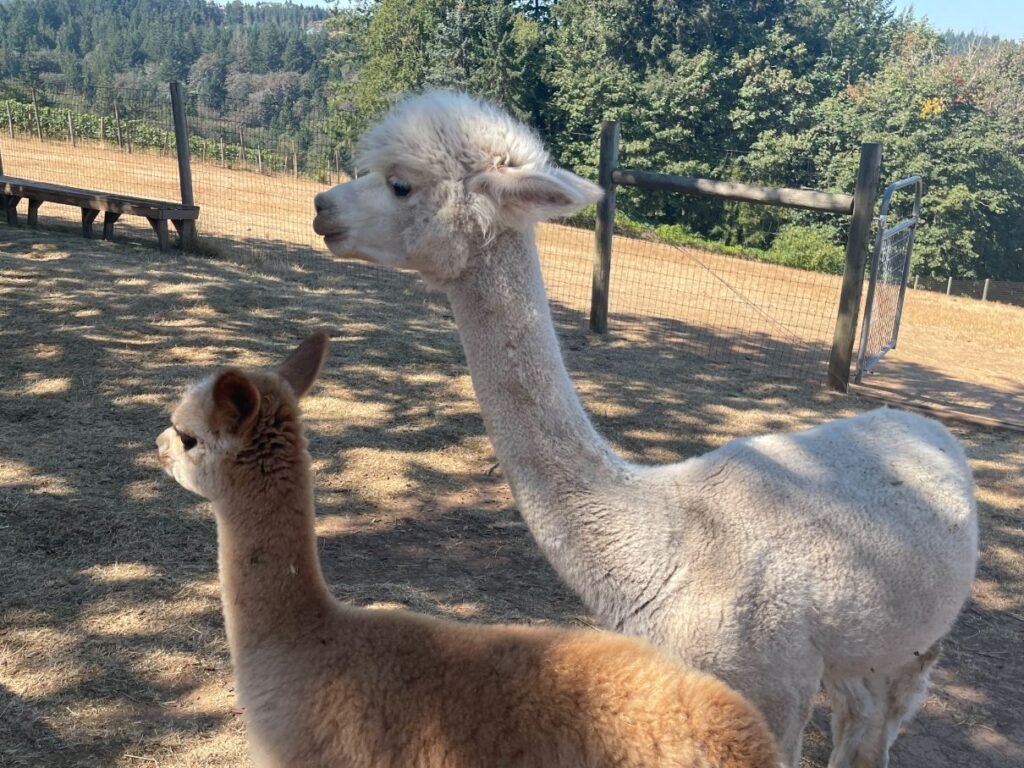
Get acquainted with some ‘fancy sheep’ at Alpacas of Oregon

Whenever possible, I seek out encounters with animals, whether it’s trekking with llamas in northern New Mexico, riding a camel in Egypt or lumbering through the jungles of Thailand atop an elephant. I’m fascinated with animal behavior and look for opportunities to observe creatures of all kinds. I’ve been fortunate to have witnessed polar bears in the Arctic, penguins in Antarctica, pink river dolphins and anaconda in the Amazon, the Big Five in Africa, tigers in India and many more such memorable experiences.
One of the most adorable of species I’ve met, however, has to be the alpaca. I discovered this during a “meet and greet” encounter at Alpacas of Oregon. Located in Oregon’s Willamette Valley, this full-service alpaca farm offers tours for the public to get up close and personal with these entertaining creatures. This fun excursion is suitable for all ages and makes for a great multi-generational activity.
Owners Doug and Suzanne Campbell have been raising alpacas for over twenty years. Suzanne is the guru when it comes to knowledge of bloodlines, fiber quality and breeding pairings. She’s also a hand spinner, who creates wonders with the exquisite fiber from the alpacas.



Doug struts his stuff in the show ring with the farm’s studs, who have won blue ribbons for both fleece and conformation. He also runs the daily operations of the farm and hosts the tours.
During a tour, you’ll learn plenty about alpacas, who Doug refers to as “fancy sheep.” These creatures are camelids, descendants of camels sans the top teeth. Alpacas’ lower teeth constantly grow throughout their lifetime and grind against their hard upper palate. This keeps them at the right length for eating and biting. They also have nails and soft padded feet, not hooves.
Alpacas weigh on average 150 pounds and are typically about five feet tall. There are two types of breeds, basically identified by their fleece. The Huacaya produce fleece that’s crimpy and curly, as well as dense and soft, while Suri alpacas have longer cylindrical locks resembling dreadlocks.


The Campbells have forty Huacaya alpacas in their herd, thirty-five of them female. It’s all about girl power here,” says Doug. Their colors are black, grey, mahogany, brown, fawn and white. And according to Doug, there are actually twenty-two shades of hues in the spectrum, with white being the most common and grey the rarest.
Females have an eleven-month gestation period and give birth to only one baby. The babies range from thirteen to fifteen pounds at birth. By day two, they start running, as it’s instinctive being prey and not predators. “They’re bred to be mules,” explains Doug, “not protectors like llamas. They’re used as pack animals in places, but raised mostly for their wool.”

Doug continues to regale us with other information such as the fact that alpacas are actually quite smart and very alert for livestock. Some of his herd even know their own names. The animals group up and sleep together, like to be clean and take care of themselves, are very disease resistant, make soft humming noises to communicate among the herd and have a life span into their late teens and early twenties. They’re also social creatures with each other, but not typically with people. And within any herd, there’s always a pecking order.
“Alpacas are cool pets,” says Doug. “They’re easy to care for on a daily basis, they’re great lawn mowers and they’re quite the characters with their own unique personalities. It’s hard not to like them.”
As we enter the area with the alpacas, Doug gives us some safety rules. Be slow and gentle around them. Don’t touch their rear-ends, as they can kick. And don’t touch their heads, as they are “head shy.” He emphasizes that alpacas don’t understand social distance and will get in your space when they know you have food for them. And sometimes they will spit – up to ten feet in spray form!
We were mingling with the females, as the males are testosterone driven and do not make the best greeters. “They basically act like drunken frat boys,” says Doug, “and are just not appropriate to introduce for this kind of tour.”

In one arena, it was clear that Mandy was the alpha. She pushed her way up to Doug, who had a container of alfalfa pellets and was very persistent in her nudging actions. Meanwhile, Doug showed us how to take a handful of the food and let the alpacas eat it out of our flattened palms. The animals crowded around us excitedly and it was obvious they were food focused, as they snarfed down the pellets. Then continued to hem us in, expecting more.
I immediately fell in love with these doe-eyed creatures that look like a mixture of a mini camel and a Goldendoodle. Some were boisterous and determined, others were shy and more passive, but they all seemed curious about what was going on around them.
In another area, we met some moms and their babes. Here, Coco assumed her position as the diva. And she took her role seriously! Doug commented that if he didn’t hold the food container above his shoulder, she would knock it down, which has happened before.
The babies were so cute and most of the time, they were near their moms. If separated and someone tried to approach one of them, usually the mom would go over and get in your way to protect her young’un.
The Campbells name each of their alpacas. I noticed that some have musicians’ names like Taylor Swift and Stevie Nicks. Others seem to be identified by their colors, such as Ginger and Silver Sparkle. And a few have a Constitution/Declaration theme like Independence, Justice and Liberty.


Once a year, the Campbells shear their alpacas and the amount of fiber shorn is anywhere from 2 ½ to 6 pounds per animal. “The stuff is incredibly soft,” comments Doug. “There are only three things softer than alpaca: silk, cashmere and vicuna.”
If you want to check out just how soft the wool really is, head for the Barn Store after your tour. You’ll find a variety of hand knit treasures made of alpaca, including scarves, sweaters, hats, vests, socks and even alpaca stuffed animals. Knowing I was going to be visiting my sweet grandbaby soon, I bought one of the stuffed animals. Soft indeed!
To learn more visit alpacasoforegon.com.



































